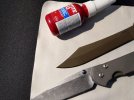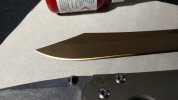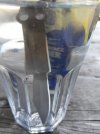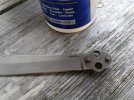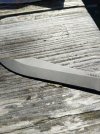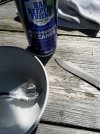- Joined
- Dec 3, 2009
- Messages
- 1,593
Hi all,
I have a 154CM steel blade that has been heat colored to a brownish color. This was a procedure done on a finished blade of a production knife. I've seen a chart indicating that that means it was heated to about 390 degrees Celcius (730F).
It is very evenly colored. I'm trying to find out how the heat coloring was done (temps, cooling etc) since I did not do it myself.
In the meantime I'm wondering if/how it might have affected the properties of the steel in terms of toughness, hardness etc. Especially toughness, since I don't want it to break upon falling.
I assume the heat applied was not for a prolonged period of time, probably in the range of minutes at most. It is a small-ish blade of around 0.14" thickness and 4" length
It seems to me this could be seen as a very short form of tempering, but tempering needs time to be executed.
see also: https://www.crucible.com/pdfs/SelectorKnifePocketRotatedCrucibleLLC.pdf
thanks for your insights!
I have a 154CM steel blade that has been heat colored to a brownish color. This was a procedure done on a finished blade of a production knife. I've seen a chart indicating that that means it was heated to about 390 degrees Celcius (730F).
It is very evenly colored. I'm trying to find out how the heat coloring was done (temps, cooling etc) since I did not do it myself.
In the meantime I'm wondering if/how it might have affected the properties of the steel in terms of toughness, hardness etc. Especially toughness, since I don't want it to break upon falling.
I assume the heat applied was not for a prolonged period of time, probably in the range of minutes at most. It is a small-ish blade of around 0.14" thickness and 4" length
It seems to me this could be seen as a very short form of tempering, but tempering needs time to be executed.
see also: https://www.crucible.com/pdfs/SelectorKnifePocketRotatedCrucibleLLC.pdf
thanks for your insights!
Last edited:

